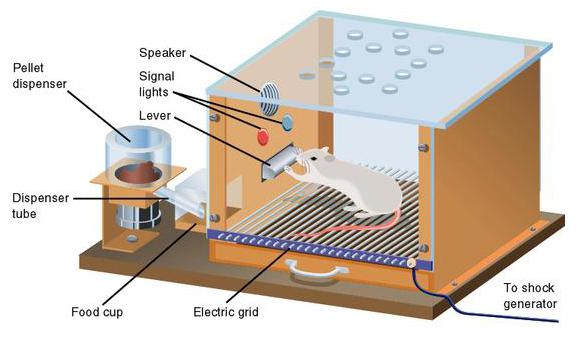Skinnerbox
(Skinnerbox)
Founder
Skinner(BurrhusFredericSkinner,1904-1990)isOneofthefoundersofnewbehavioristpsychology.HewasbornonMarch20,1904inastationtowninnortheasternPennsylvania,wherehespenthischildhoodandmiddleschoolyears.Outofinterestinliterature,heenteredHamiltonCollege,majoringinEnglishLiterature.Originally,hewantedtobeawriterandstartedwritingaftergraduation,buttwoyearslaterhefeltthat"thereisnothingimportanttosay".SohewasadmittedtoHarvardUniversityin1928tostudyasagraduatestudentandchangedhisstudiestopsychology.In1931hereceivedadoctorateinphilosophy.Sincethen,hehastaughtattheUniversityofMinnesotaandIndianaUniversity.In1947,hewashiredtoreturntoHarvardUniversityasatenuredprofessoroftheschool'spsychologydepartment.
ExperimentalTheory
NewBehavioralLearningTheory—OperationalConditioning
ExperimentalContent
Skinner'sRegardingOperationalConditioningTheeffectexperimentwascarriedoutinthefamousSkinnerbox,ananimalexperimentinstrumenthedesigned.Putawhitemouseorpigeoninthebox,andsetaleverorkey.Thestructureoftheboxexcludesallexternalstimuliasmuchaspossible.Animalscanmovefreelyinthebox.Whenitpressestheleverorpecksthekey,amassoffoodwillfallintothetrayunderthebox,andtheanimalcaneatthefood.Thereisadeviceoutsidetheboxtorecordthemovementsoftheanimals.ThedifferencebetweenSkinner’sexperimentandPavlov’sconditionedreflexexperimentis:(1)ThetestanimalintheSkinnerboxcanmovefreelyinsteadofbeingtiedtoashelf;(2)thetestanimal’sThereactionisnotcausedbyaknownstimulus.Manipulativebehavior(pressingtheleverorpeckingthekey)isameanstoobtainenhancedstimulation(food);(3)Thereactionisnotsalivaryglandactivity,butskeletalmuscleactivity;(4)Thepurposeoftheexperimentisnottorevealthelawsofcerebralcortexactivity,buttoshowtherelationshipbetweenstimulusandresponse,soastoeffectivelycontrolthebehavioroftheorganism.
TheconceptofoperationalconditioningisthecoreofSkinner'snewbehaviorallearningtheory.Skinnerdividesbehaviorintotwocategories:oneisresponsivebehavior,whichisaresponsecausedbyaknownstimulus;theotherisoperationalbehavior,whichisaresponseoftheorganismitself,andhasnothingtodowithanyknownstimulus.Correspondingtothesetwotypesofbehavior,Skinnerdividesconditionedreflexintotwotypes.Correspondingtoresponsivebehaviorisresponsivereflex,calledS(stimulation)type(thenameofStypecomesfromEnglishStimulation);correspondingtooperativebehaviorisoperativereflex,calledR(reaction)type(thenameofRtypecomesfromEnglishReaction).S-typeconditionedreflexisdirectlyrelatedtoreinforcementandstimulus,andR-typeconditionedreflexisdirectlyrelatedtoreinforcementandresponse.Skinnerbelievesthathumanbehaviorismainlyanoperationalbehaviorcomposedofoperationalreflections,andoperationalbehaviorsarebehaviorsthatactontheenvironmentandproduceresults.Inlearningsituations,operationalbehaviorsaremorerepresentative.SkinnerattachesgreatimportancetoR-typeconditioning,becausethisreflexcanshapenewbehaviors,whichisespeciallyimportantinthelearningprocess.
Experiment1:Putaveryhungrymouseintoaboxwithbuttons,andeachtimeyoupressthebutton,foodwillbedropped.
Result:Themouselearnedtopressthebuttonspontaneously.
ThisexperimentgoesastepfurtherthanthePaplovexperimentof"rattlebell-feeding"toestablishbehavior.
Whatislearning?Itmeanstoestablishadependentrelationshipbetweenbehaviorandtheneedsoftheoperator.Inotherwords,maketheactorsfeelthat"behavior"and"reward"areconnected.
Aslongasthebehaviorsandrewardsarecontinuouslyrepeatedandconnected,theoperator'sbehaviormodecanbecultivated.
Rewardscancultivatebehaviorhabits,right?ThenlookatExperiment2.
2.Behaviorandpunishment
Experiment2:Putamouseinaboxwithbuttons.Everytimethemousedoesnotpressthebutton,theboxisenergized.
Result:Themouselearnedtopressthebutton.
Butunfortunately,oncetheboxisnolongerpoweredon,thebehaviorofthemousepressingthebuttonquicklydisappears.
"Punishment",asarewardforeviltwins,canquicklyestablishbehaviorpatterns.However,punishmenthascertainsideeffects:thebehaviorpatternsitestablishescomeandgofast.Oncethepunishmentdisappears,thebehaviorpatternwilldisappearquickly.
Inthelongrun,punishmentwillnotplayasignificantroleinstoppingbehavior.Inreallife,becauseoftheVebleneffectofpunishment,sometimesthepunishmentcanevenbecounterproductive.

TheVebleneffect:AmericanscholarVeblenbelievesthat,unlikethegeneralrulethatthelowerthepriceofaproduct,thegreaterthedemand,thehigherthepriceofaparticularproduct,thegreaterthedemand.Thepurposeofconsumptionofpartoftheupperclassistoshowofftheirsocialstatusandsuccess,andtosatisfytheirvanity,sothehighertheprice,thehigherthedemand.Onthecontrary,ifthepriceislowered,theboundariesreflectingtheupperclasswillbecomeblurred,sothedemandwilldecrease.
Ifyouwanttocontroltheactornottoperformacertainbehavior,youshouldfindthe"reward"ofthewrongbehaviorandremovetherewardtostopthewrongbehavior.
However,evenifitisareward,thelearningbehaviorofmicewillgraduallydisappearwhennofoodisdropped(althoughitdisappearsslightly).Andthisisawasteoffood!WhatshouldIdo?
Nextisexperiment3.
3.Fixedtimereward
Experiment3:PutaveryhungrywhitemouseintotheSkinnerbox,Atthebeginning,thefoodhasbeendropped,andgraduallydecreasedtoevery1minute.Afterpressingthebutton,theprobabilityoffoodbeingdropped.
Result:Themousekeptpressingbuttonsatfirst.Afteraperiodoftime,themouselearnedtopressthebuttononceevery1minute.
Whenthefallingfoodstops,thebehaviorofthemousedisappears.
Tsk,itfailed.Didnotcultivatethebehaviorofthemousetopressthebuttoncontinuously,butmadethemouse"lazy".Why?Becausetheactorknowsthatthebehaviorwillnolongerberewardedintheshortterm.……Allright.Themostcriticalexperiment4.
4.Probabilisticrewards
Experiment4:PutaveryhungrywhitemouseintotheSkinnerbox,severaltimesPressthebutton,theprobabilityoffallingfood.
Result:Themouselearnedtokeeppressingthebutton.
Whennofoodisdropped,thelearningbehaviorofmicedisappearsveryslowly.
Astheprobabilitygetslowerandlower,thelearningbehaviorofthemousebypressingthebuttondoesnotchange.Untilafoodisdroppedfromthebutton40-60times,themousewillstillkeeppressingthebuttonforalongtime..
(Similarly,doexperimentswithpigeons.Onaverage,pigeonswithfoodfortificationwithvaryingtimeintervalsareobtainedevery5minutes,andtheycanreact2-3timespersecondforupto15hoursofcontinuousreaction)
p>
Thisexperimentsimulateswhy"gambling"-suchassimpleslotmachines,ormorecomplexgambling-willgivehumansasenseofdependence,oraddiction.
Becauseoftheprobabilisticresults,itisdifficultfortheactortointuitivelyjudgewhetherthemechanismisinvalid,soasinglefailurewillnotgiveanobvious"punishment"effect,terminatethehabitoftheactor,andthustheactor'slearningThebehaviorwillcontinueforever.
Thenaninterestingexperiment5.
5.Superstitiousguineapig?
Experiment5:Well,infact,experiment5isstillexperiment4,aprobabilisticSkinnerbox.
Result:Manyofthesemicehavedevelopedpeculiarbehaviors,suchashittingboxes,playingtricks,ordancingincircles.
Thisisbecausethemiceareperformingthesebehaviorsjustbeforethefoodisdropped,so"superstition"arises.
Manyrumorsingames,suchas"it'seasytogetabigprizeinthenoondraw",or"abackpackfullofluckyrabbitfeetcangetbetterequipment",theprincipleisthesame.
Experimentalsignificance
Skinnerfoundthroughexperimentsthatthelearningbehaviorofanimalsoccurswithastimulusthatplaysastrengtheningrole.Skinnerextendedthelearningbehaviorofanimalstothelearningbehaviorofhumans.Hebelievedthatalthoughthenatureofhumanlearningbehaviorismuchmorecomplicatedthanthatofanimals,itmustalsobethroughoperationalconditioning.Thecharacteristicofoperantconditioningisthatthestrengtheningstimulusdoesnotoccursimultaneouslywiththereaction,nordoesitprecedethereaction,butoccurswiththereaction.Theorganismmustfirstmakethedesiredresponse,andthengetthe"reward",thatis,strengthenthestimulus,sothatthisresponseisstrengthened.Theessenceoflearningisnotasubstitutionofstimuli,butachangeinresponse.Skinnerbelievesthatalmostallhumanbehavioristheresultofoperationalreinforcement,anditispossibleforpeopletochangethereactionofothersthroughtheinfluenceofreinforcement.Inteaching,teachersactasdesignersandarchitectsofstudentbehavior,breakingdownlearninggoalsintomanysmalltasksandstrengtheningthemonebyone.Studentsgraduallycompletelearningtasksthroughoperationalconditioning.
